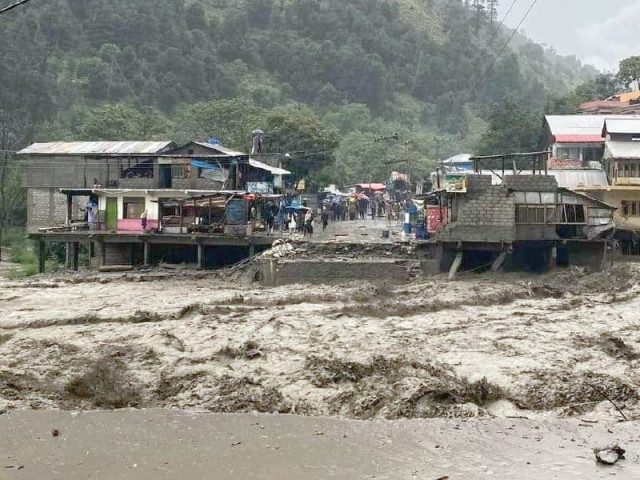The National Disaster Management Authority (NDMA) has sounded a nationwide alert over the risk posed by ongoing monsoon rains, with warnings in effect until July 25 for various regions across Pakistan. The NDMA cautioned about the threat of landslides, flash floods, and Glacial Lake Outburst Floods (GLOF) in the northern mountainous areas, as well as the possibility of riverine flooding in several provinces. The warning comes as the country continues to battle the devastating effects of heavy rain, which has already caused significant loss of life and property.
High-Risk Regions and River Flood Alerts
According to NDMA, heavy rains in the northern regions could trigger landslides and GLOF events, particularly in vulnerable areas such as Reshun, Brep, Booni, Sardar Gol, Thulo, Hunarchi, Darkut, and Ishkoman. The Karakoram Highway and Babusar Top have already faced blockages due to landslides, further complicating rescue and relief operations. Tourists have been strongly advised to avoid mountainous regions until the warning period ends.
The NDMA has also highlighted the risk of increased water flow in major river systems, including the Indus, Chenab, Jhelum, and Kabul rivers. Flooding of low to moderate intensity is anticipated at Marala, Khanki, and Qadirabad on the Chenab, with additional swelling expected at Mangla on the Jhelum and Nowshera on the Kabul. Rising water levels are also a concern at key points along the Indus, such as Tarbela, Kalabagh, Chashma, Taunsa, and Guddu barrages. In Khyber Pakhtunkhwa, the Swat and Panjkora rivers are flagged for potential flooding, while in Gilgit-Baltistan, rivers like Hunza and Shigar, as well as smaller streams, are at risk.
Balochistan is bracing for potential flash floods in Zhob, Sherani, Sibi, and Musakhel, with meteorological forecasts predicting further rainfall in the coming days. The NDMA continues to monitor these developments closely, coordinating with provincial authorities and advising residents in flood-prone areas to remain vigilant.
Monsoon Casualties and Ongoing Rescue Efforts
The human cost of this year’s monsoon is mounting. As of the latest NDMA figures, at least 242 people have lost their lives nationwide since late June, with 11 new fatalities reported in Khyber Pakhtunkhwa (KP) and Gilgit-Baltistan (GB) alone on Tuesday. Flash floods in both regions have swept through communities, damaging homes, crops, irrigation systems, and infrastructure. Among the recent fatalities in KP, Swat reported six deaths—including four children—while Bajaur, Buner, and Upper Kohistan also saw lives lost.
In addition to the tragic deaths, hundreds have been injured, and nearly 830 houses have been destroyed. Livestock losses are also considerable, with over 200 animals perishing in the floods. Punjab remains the hardest-hit province, recording the highest number of fatalities.
Rescue operations have been intensive, with Prime Minister Shehbaz Sharif instructing the NDMA to work closely with provincial agencies to provide rapid relief. In a dramatic rescue, around 250 tourists stranded by landslides on Babusar Highway were saved by a coordinated effort involving local administration, police, volunteers, and army personnel. However, 10 to 15 individuals are still missing in the region, with search operations ongoing.
Flooding Across Punjab and Urban Challenges in Lahore
Punjab has seen extensive flooding in low-lying districts, with evacuation orders issued in cities like Muzaffargarh, Dera Ghazi Khan, and Rahim Yar Khan. Rising river levels have inundated over 20 villages in Jhang due to the swelling Jhelum River. Meanwhile, concerns remain over possible water discharges from Indian dams affecting the Beas and Sutlej rivers.
In Lahore, record-breaking rainfall has caused widespread urban flooding, submerging roads, highways, and residential neighborhoods. The highest rainfall was recorded in Tajpura at 110 mm, with multiple localities receiving well over 90 mm. This deluge has severely disrupted daily life, stranding vehicles and slowing emergency response efforts.
Karachi, Balochistan, and Further Weather Updates
Karachi witnessed cloud cover and sporadic drizzle, with the Pakistan Meteorological Department forecasting continued light rain and humid conditions. Temperatures hovered around 30°C, with humidity levels at 68 percent. In Balochistan, most regions experienced hot and humid weather, though rain is forecast for districts including Kohlu, Musakhel, Loralai, Zhob, Kalat, and Khuzdar, while coastal areas like Gwadar and Jiwani remained relatively cooler.





